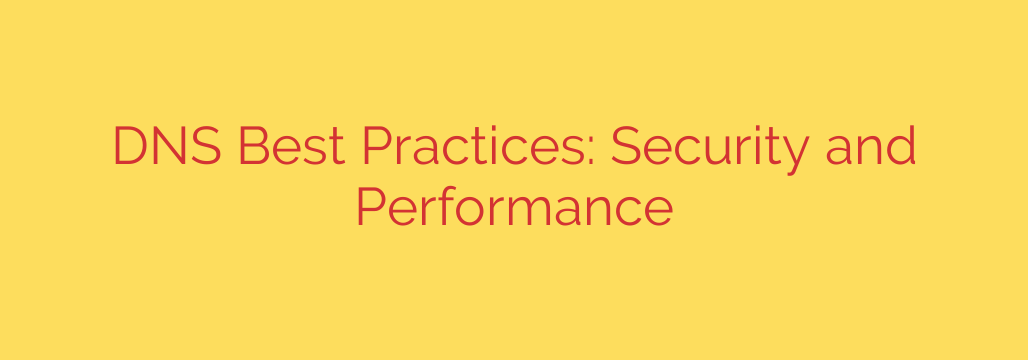
Your Ultimate Guide to DNS Security and Performance Best Practices
The Domain Name System (DNS) is one of the unsung heroes of the internet. It acts as the internet’s address book, translating human-friendly domain names like yourwebsite.com into the machine-readable IP addresses necessary to locate servers and deliver content. While it often operates silently in the background, a poorly managed DNS can create significant vulnerabilities and performance bottlenecks.
If your DNS is slow, your website is slow. If your DNS goes down, your website is offline. And if your DNS is insecure, you risk exposing your users and your business to serious threats. Optimizing your DNS is not just a technical task—it’s a critical business practice for ensuring a secure, fast, and reliable online presence.
Here’s a comprehensive look at the best practices for bolstering your DNS security and maximizing its performance.
Fortifying Your Defenses: Key DNS Security Practices
DNS has become a primary target for cyberattacks. Attackers know that disrupting a company’s DNS can cause widespread outages and be used to redirect unsuspecting users to malicious sites. Protecting this core infrastructure is non-negotiable.
Here are the essential security measures you should implement:
Enable DNSSEC (Domain Name System Security Extensions). Think of DNSSEC as a digital signature for your DNS records. It validates that the DNS response received by a user is authentic and has not been tampered with in transit. This is your primary defense against cache poisoning and man-in-the-middle attacks, where an attacker tries to redirect your traffic to a fraudulent site.
Implement DNS Redundancy. Relying on a single DNS provider or a single set of nameservers creates a single point of failure. If that provider has an outage, your website and all associated services become inaccessible. Use at least two different DNS providers—a primary and a secondary—to ensure that if one fails, the other can continue to resolve your domain’s queries.
Use Query Rate Limiting. Distributed Denial of Service (DDoS) attacks often target DNS servers by overwhelming them with a flood of queries. Rate limiting helps mitigate this by automatically limiting the number of queries a single source can make in a given period. This prevents malicious actors from consuming all your server resources and keeps your DNS available for legitimate traffic.
Restrict Zone Transfers. A DNS zone transfer is the process of copying the entire contents of a DNS zone file from a primary to a secondary server. While necessary for redundancy, an unrestricted zone transfer can be exploited by attackers to map out your entire network infrastructure. Configure your nameservers to only allow zone transfers to specific, authorized IP addresses belonging to your secondary DNS servers.
Actively Monitor and Log Queries. You cannot protect against what you cannot see. Set up robust logging for all DNS queries and monitor these logs for unusual patterns, such as a sudden spike in queries from a specific region or a large number of failed lookups (NXDOMAIN responses). This proactive monitoring can help you detect and respond to an attack before it causes significant damage.
Supercharging Your Speed: DNS Performance Optimization
In today’s digital landscape, speed is everything. A slow DNS lookup adds latency to every single initial connection to your website, frustrating users and negatively impacting your search engine rankings. A fast DNS means a better user experience from the very first click.
Follow these tips to ensure your DNS is performing at its peak:
Leverage a Global Anycast Network. This is one of the most effective ways to reduce DNS latency. An Anycast network routes DNS queries to the geographically closest nameserver to the user. This means a user in London is served by a server in Europe, while a user in Tokyo is served by one in Asia. The result is dramatically faster lookup times for a global audience. Basic DNS provided by many domain registrars does not offer this feature.
Optimize Your TTL (Time to Live) Values. TTL tells DNS resolvers how long to cache a DNS record before requesting a fresh copy. There is a trade-off here:
- Long TTLs (e.g., 24-48 hours) reduce the load on your nameservers and speed up lookups for repeat visitors, but they make DNS changes (like moving to a new server) propagate slowly.
- Short TTLs (e.g., 5-30 minutes) allow for rapid DNS changes but increase the query load on your nameservers.
Set longer TTLs for stable records like MX (mail) records and shorter TTLs for records you may need to change quickly, like A or CNAME records for critical web services.
Minimize CNAME Record Chains. A CNAME record points one domain to another. While useful, each CNAME in a chain requires an additional DNS lookup, adding latency. For example, pointing
blog.yourwebsite.comtoservice.provider.comis fine. But ifservice.provider.comthen points to another CNAME, you’ve created a chain that slows down resolution. Whenever possible, point directly to an A record to avoid these extra steps.Choose a High-Performance DNS Provider. Not all DNS providers are created equal. The free or bundled DNS services offered by domain registrars are often built for cost, not performance or security. Investing in a premium, managed DNS provider gives you access to advanced features like a global Anycast network, robust DDoS protection, high uptime SLAs, and expert support, which are crucial for any serious online business.
By treating DNS as a critical component of your digital strategy, you can build a faster, more secure, and more resilient online presence that serves your users and protects your brand.
Source: https://www.redswitches.com/blog/18-dns-best-practices/








